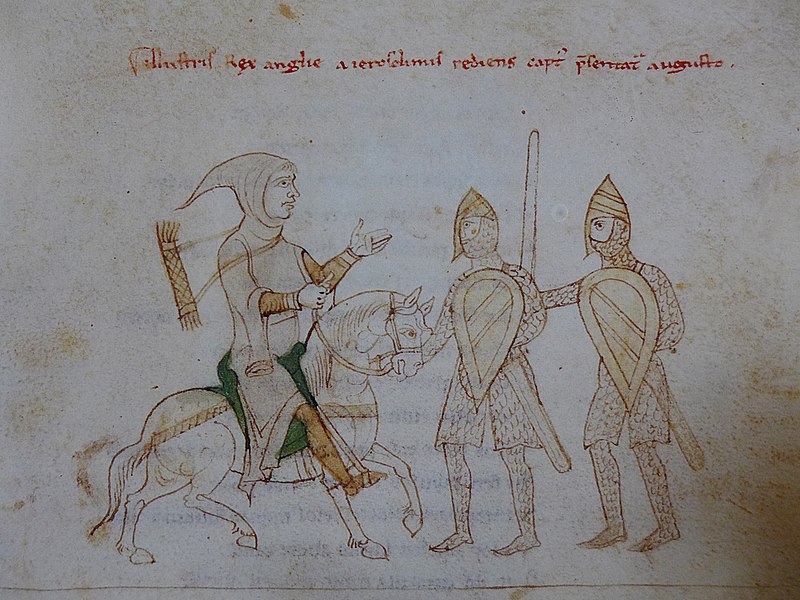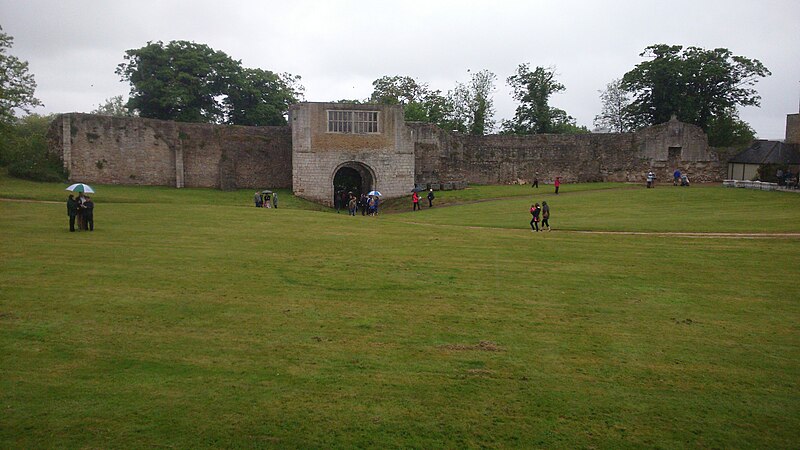 |
| Dover Castle |
An Ignominious Return Home
Geoffrey too
decided to come home. With Prince John siding with his enemies and Geoffrey
likely to do the same, Longchamp viewed the king’s half-brother as a threat to
his own position. In September 1191 Geoffrey arrived back in England, landing
in Dover on 14th in contravention of his oath. Prince John
warned his half-brother of the danger of arrest.
Longchamp
ordered Geoffrey’s arrest. Geoffrey had a horse waiting for him on the beach
when he landed and managed to evade the men sent to arrest him. One of the
castellan[i]
of Dover’s men caught Geoffrey’s bridle, but the 40 year old church man was still
agile enough to kick his pursuer off and managed to make it to the priory of St Martin which was immediately surrounded.
The priory
was besieged for four days after which the castellan’s men entered the abbey
and dragged Geoffrey from the altar. Geoffrey was hauled through the streets of
Dover, his head banging on the ground. Gerald of Wales[ii] wrote;
‘The castellan’s men grabbed
him by the feet and arms, carried the struggling archbishop from the altar and
handled him so roughly that his head hit the pavement of the church heavily….he
was brought through the muddy streets of the town to the castle where he was
delivered to the constable[iii].’[iv]
This act, so
reminiscent of the treatment meted out to Thomas Beckett by Henry II, turned the clergy against Longchamp.
In
retaliation Prince John and Walter de Coutances summonsed Longchamp to appear
before a council to be held at Reading. Longchamp hightailed it off to London where he shut himself
up in the Tower. After a three day siege he surrendered on 10th
October, leaving the country under guard at the end of the month. The council
named Prince John as supreme governor of the realm while de Coutances took the
post of Justiciar.
Clerical Quarrels
Once things had settled down in the south Geoffrey returned to York;
this time he was formally consecrated archbishop and had papal approval to
boot. Geoffrey was formally enthroned as archbishop on 2nd November
1191; his enemy Hugh de Puiset failed to attend in his role as Bishop of
Durham.
Geoffrey summonsed Puiset to explain his absence at a provincial synod in late September 1191, at which the
bishop was charged with various irregularities. Puiset appealed to Rome and
refused to attend the synod, and was excommunicated in December by Geoffrey.
An attempt
in March 1192 by Eleanor and Hubert Walter to settle the issue came to nothing
when Geoffrey insisted on a pledge of obedience from Puiset, who in turn
demanded an admission from Geoffrey that the excommunication had been unjust.
Geoffrey turned up before the queen at the head of a solemn procession of clerics, his arch-episcopal cross carried before him. Geoffrey refused to be reconciled with Puiset until he made a solemn promise of obedience. Further appeals to Rome led to an eventual settlement in October 1192, when the bishop finally acknowledged Geoffrey's authority over Durham.
 |
| Godstow Abbey |
Seeing the possibilities in this situation, Puiset’s supporters among
the canons refused to cooperate with Geoffrey’s officials and got excommunicated
for their pains. They closed the Minster, refused to allow the bells to be
rung, locked up the archbishop’s stall in the choir and blocked up the door by
which Geoffrey entered the Minster from his palace.
In another run in with Geoffrey, Alice, the Prioress of Clementhorpe
Priory[v] refused
to agree to Geoffrey’s plans for the reorganisation of her convent,
subordinating it to Godstow
Abbey[vi]. She, in
her turn, was excommunicated.
R
ichard’s
bosom pal Philip reached home in early 1192; he claimed that on crusade Richard
had been insolent, full of pride and treachery. Philip went so far as to hint
that Richard had had Philip poisoned. Philip and Richard’s friendship was never
destined to last; Richard was determined to keep his French holdings, which
Philip coveted. By March 1192 the news of Philip’s treachery had reached
Richard along with details of the deteriorating conditions at home.
 |
| Richard's capture |
Richard did
not leave Outremer until the summer; en route home, shortly before Christmas
1192 Richard was captured[vii]
near Vienna by Leopold V, Duke of Austria. Leopold accused Richard of arranging
the murder of his cousin Conrad
of Montferrat while
on crusade[viii].
Richard was held at Dürnstein Castle.
 |
| Leopold (2nd L) and Henry IV (C) |
Leopold’s
liege lord, the Holy Roman Emperor Henry VI, had Richard brought to his court at
Regensburg at the beginning of January. The
bargaining for Richard’s ransom began, starting at 100,000 marks[ix].
Henry VI wrote to Philip;
‘Inasmuch
as he [Richard] is now in our power and has always done his utmost to annoy and
disturb you, we thought it right to notify Your Highness, for we know that
these tidings will bring you most abundant joy.’[x]
By
mid-January Prince John was on his way to Paris, where he did homage to Philip
for Normandy and all Richard’s other lands. He promised to marry Alys and hand
over Gisors and the Vexin to Philip.
John’s Rebellion
 |
| Tickhill Castle gatehouse |
John then
hurried home to stir up a rebellion against his brother. John looked first to
William the Lion who refused to join in the fun. He did however find an ally in
Baldwin, Duke of Hainault[xi]. John used Welsh and Flemish mercenaries to garrison Tickhill Castle Wallingford and Windsor castles, claiming that Richard
was dead and that, therefore, John was king. Philip meanwhile attacked
Normandy; the great castle of Gisors was surrendered without a fight.
Eleanor and
the Justiciars joined forces to counter John’s
rebellion. Geoffrey and Hugh du Puiset put aside their feud to quash the
uprising. Geoffrey strengthened Doncaster's defences and went to the
aid of Puiset, who was besieging Tickhill.
The haggling
over Richard’s ransom took over a year; bidding from all parties was fierce. On
25th March 1193 Richard agreed to pay the 100,000 marks and supply
Henry VI with the service of fifty galleys and 200 knights for a year. He was
to provide Henry with hostages.
William
Longchamp was involved in the diplomacy on Richard’s behalf and April 1193 he
returned to England with exhortations from Richard and Henry VI that the
English pay Richard’s ransom with all due expedition.
Eleanor and the Justiciars levied a 25% tax on income and the value of
moveable property. They appropriated this year’s wool crop from Cistercian
monasteries, along with gold and silver plate from the country’s churches.
Similar measures were enacted in Richard’s continental possessions.
Finally, on 13th March the king returned home;
‘The
news of the coming of the King, so long and so desperately awaited, flew faster
than the north wind.’[xii]
John’s rebellion withered in the wind. But Richard’s long absence had
cost him dear; lands had been lost to both Henry VI and Philip. That worse had
not happened can be considered as a direct result of the administrative system
set up by his father.
Further Disturbances in York
 |
| Pope Celestin III |
Geoffrey’s uncompromising attitudes meant that men who’d served him for
many years began to turn against him. In 1193 when the office of Dean of York became vacant Geoffrey
faced difficulties with his appointee to the post. Geoffrey's first choice, Simon of Apulia, the chancellor of York who had
served Geoffrey for many years, refused to give up the office when Geoffrey
changed his mind and decided to award the post to his half-brother Peter[xiii].
Simon was
supported by the cathedral chapter, who elected him to the office despite
Geoffrey's opposition. Geoffrey appealed to Pope Celestine III while Simon travelled to see the king in Germany. Richard
refused to allow the appeal and tried to summon Geoffrey to Germany to resolve
the issue. Geoffrey was unable to leave York because of disturbances within the
cathedral clergy, and Simon managed to secure papal confirmation as Dean of
York.
In 1194
Geoffrey went into debt to the crown for the sum of 3000 marks[xiv]
to buy the office of Sheriff of Yorkshire for himself. Later that year Geoffrey
began a quarrel with Hubert Walter, who had been nominated archbishop by
Richard[xv],
over the question of which archbishop had primacy over England, which Canterbury claimed and York
disputed. Walter's decision to have his episcopal cross carried before him in
the diocese of York in March 1194 was symbolic of his claim to primacy over
York and all of England.
Geoffrey
responded by having his own cross carried before him in the diocese of
Canterbury the following month. Richard did not reprimand Geoffrey for this act
of provocation, and even went so far as to restore some of his confiscated
estates.
Bibliography
Philip
Augustus – Jim Bradbury, Longman 1998
King John –
Stephen Church, MacMillan 2013
Early
Medieval England – MT Clanchy, The Folio Society 1997
Richard the
Lionheart – John Gillingham, George Weidenfeld and Nicholson 1989
The Royal
Bastards of Medieval England – Chris Given- Wilson and Alice Curteis, Barnes
& Noble Books 1995
The
Plantagenets – Dan Jones, William Collins 2012
King John –
WL Warren, Yale University Press 1997
Eleanor of
Aquitaine – Alison Weir, Jonathan Cape 1999
The
Plantagenets – Derek Wilson, Quercus Editions Ltd 2014
www.wikipedia.en
[i]
The castellan was married to Longchamps’ sister
[ii]
Geoffrey was Gerald’s patron
[iii]
Those involved in this sacrilege were excommunicated by Hugh of Lincoln
[iv]
King John - Church
[v]
A convent in one of the parishes in York, closed down in 1536
[vi]
In Oxfordshire
[vii]
Several of his knights had already been taken by Meinhard of Görz
[ix]
Comparisons of wealth are not calculated for before the year 1270, if this
ransom had been demanded then, not in 1193, then the relative worth in 2014
would be historic standard of
living value of that income or
wealth is £85,460,000.00 labour earnings of
that income or wealth is £1,508,000,000.00 economic status value of that income or wealth is £3,572,000,000.00 economic power value of that income or wealth is £29,120,000,000.00 www.measuringworth.com
[x]
Richard the Lionheart - Gillingham
[xi]
Philips’ father-in-law.
[xii]
Eleanor of Aquitaine - Weir
[xiii]
A maternal relative
[xiv]
The pound, the mark, the franc and a number of other European currencies were
almost equivalent in value. Comparisons of wealth are not calculated for before
the year 1270, if the office had been bought then, not 1194 then the relative
worth in 2014 would be historic standard of living value of that income or
wealth is £2,564,000.00 labour earnings of that income or wealth is £45,230,000.00 economic status value of that income or
wealth is £107,200,000.00 economic power value of that income or wealth is £873,700,000.00 www.measuringworth.com
[xv]
Without consulting the bishops
A period of stiff-necked priests ...
ReplyDeleteInteresting but I probably should have read Parts 1-3 first!
ReplyDelete